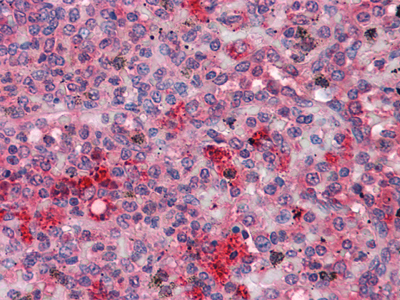c-Fgr Monoclonal Antibody
- Catalog No.:YM0151
- Applications:WB;IHC;IF;ELISA
- Reactivity:Human;Mouse
- Target:
- c-Fgr
- Fields:
- >>Chemokine signaling pathway
- Gene Name:
- FGR
- Protein Name:
- Tyrosine-protein kinase Fgr
- Human Gene Id:
- 2268
- Human Swiss Prot No:
- P09769
- Mouse Gene Id:
- 14191
- Mouse Swiss Prot No:
- P14234
- Immunogen:
- Purified recombinant fragment of human c-Fgr expressed in E. Coli.
- Specificity:
- c-Fgr Monoclonal Antibody detects endogenous levels of c-Fgr protein.
- Formulation:
- Liquid in PBS containing 50% glycerol, 0.5% BSA and 0.02% sodium azide.
- Source:
- Monoclonal, Mouse
- Dilution:
- WB 1:500 - 1:2000. IHC 1:200 - 1:1000. ELISA: 1:10000.. IF 1:50-200
- Purification:
- Affinity purification
- Storage Stability:
- -15°C to -25°C/1 year(Do not lower than -25°C)
- Other Name:
- FGR;SRC2;Tyrosine-protein kinase Fgr;Gardner-Rasheed feline sarcoma viral;v-fgr) oncogene homolog;Proto-oncogene c-Fgr;p55-Fgr;p58-Fgr;p58c-Fgr
- Molecular Weight(Da):
- 59kD
- References:
- 1. Immunity. 2005 Feb;22(2):235-46.
2. Biochemistry. 2007 Oct 2;46(39):11023-32.
- Background:
- This gene is a member of the Src family of protein tyrosine kinases (PTKs). The encoded protein contains N-terminal sites for myristylation and palmitylation, a PTK domain, and SH2 and SH3 domains which are involved in mediating protein-protein interactions with phosphotyrosine-containing and proline-rich motifs, respectively. The protein localizes to plasma membrane ruffles, and functions as a negative regulator of cell migration and adhesion triggered by the beta-2 integrin signal transduction pathway. Infection with Epstein-Barr virus results in the overexpression of this gene. Multiple alternatively spliced variants, encoding the same protein, have been identified. [provided by RefSeq, Jul 2008],
- Function:
- catalytic activity:ATP + a [protein]-L-tyrosine = ADP + a [protein]-L-tyrosine phosphate.,similarity:Belongs to the protein kinase superfamily. Tyr protein kinase family. SRC subfamily.,similarity:Contains 1 protein kinase domain.,similarity:Contains 1 SH2 domain.,similarity:Contains 1 SH3 domain.,subunit:Binds PTPNS1.,
- Subcellular Location:
- Cell membrane ; Lipid-anchor ; Cytoplasmic side . Cell membrane; Peripheral membrane protein; Cytoplasmic side. Cell projection, ruffle membrane. Cytoplasm, cytosol. Cytoplasm, cytoskeleton. Mitochondrion inner membrane . Mitochondrion intermembrane space . Detected in mitochondrial intermembrane space and at inner membranes (By similarity). Colocalizes with actin fibers at membrane ruffles. Detected at plasma membrane lipid rafts. .
- Expression:
- Detected in neutrophils, monocytes and natural killer cells (at protein level). Detected in monocytes and large lymphocytes.
- June 19-2018
- WESTERN IMMUNOBLOTTING PROTOCOL
- June 19-2018
- IMMUNOHISTOCHEMISTRY-PARAFFIN PROTOCOL
- June 19-2018
- IMMUNOFLUORESCENCE PROTOCOL
- September 08-2020
- FLOW-CYTOMEYRT-PROTOCOL
- May 20-2022
- Cell-Based ELISA│解您多样本WB检测之困扰
- July 13-2018
- CELL-BASED-ELISA-PROTOCOL-FOR-ACETYL-PROTEIN
- July 13-2018
- CELL-BASED-ELISA-PROTOCOL-FOR-PHOSPHO-PROTEIN
- July 13-2018
- Antibody-FAQs
- Products Images

- Western Blot analysis using c-Fgr Monoclonal Antibody against HL60 (1) Raw264.7 (2) cell lysate.

- Immunohistochemistry analysis of paraffin-embedded human Spleen tissues with AEC staining using c-Fgr Monoclonal Antibody.



